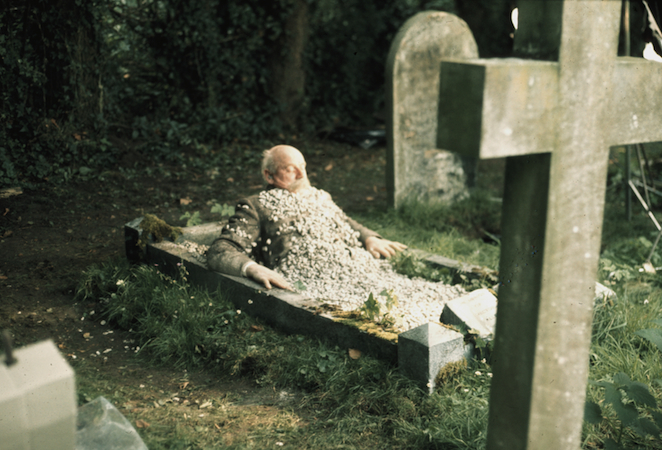What’s the weirdest zombie film you’ve ever seen? Zombeavers? Fido? Anna and the Apocalypse?
I’ll see you and I’ll raise you: David Gladwell’s Requiem for a Village.
Gladwell is mainly remembered as the editor of Lindsay Anderson’s If… and O Lucky Man!, and Requiem for a Village is, well, not remembered at all. Not that its struggle to find an audience is exactly perplexing. The first question it asks the viewer to confront is what the hell they’re even watching.
Clocking in at just 78 minutes, Requiem for a Village (1976) spends a solid ten of them conning you that it’s a documentary feature but without the expected voiceover. Static shots of a soulless ‘70s housing estate form a visually bland montage until the camera settles on a garden shed behind one of them, from which an old man wheels a pushbike. The film then tracks his journey out of the suburbs, along a bypass (lorries go rumbling past him) and into the countryside. He fetches up at a church where he tends graves. Interspersing this are shots of the natural world and some mumbled dialogue between a local landowner and a developer. Earth-moving equipment moves in on the woodland.
So far, so self-evident. Juxtapositions abound: lower-middle class/landed gentry; suburban/rural; traditionalism/modernity. The shift from bland imagery to hazy, hypnotic cinematography once Gladwell focuses on the natural world gives the whole thing the feel of Ronald Blythe’s Akenfield approached as an art-film by somebody with a Werner Herzog fixation (which, come to think of it, is a fairly accurate description of Peter Hall’s actual film version of Akenfield, made two years before Requiem for a Village).
But before the film can go any further down this path, Gladwell pulls a stylistic switcheroo as the dead rise from the graves. Not all of them, mind, just a demographic specific to a particular time (the mid-1800s) and event (a wedding party). They file into the church, fill the pews and experience a mass hallucination of the nuptials while Gladwell occasionally cuts back to the here and now as a local pressure group gather in the church hall to plan their campaign against the development.
The flashback – encompassing the wedding party, a subsequently harvest and a couple of nasty bits of sexual violence that leech away any hint of the pastoral – occupies the middle third of film and leaves the undead-occupy-the-church sequence with nowhere to go, let alone the potential to follow expected zombie film tropes. If anything, the zombies come across as little more than a narrative device to shunt the film into the past – something that could easily have been achieved via dialogue or editing. Nor is there another zombie scene until the end when the effect is pathos rather than terror.
What the zombie business does, ultimately, is strengthen the points of comparison between past and present (the windbag speechifying at the wedding/the windbag puffing himself up at the protest meeting; wheelwrights and blacksmiths making things/heavy plant equipment destroying things; piece of shit farm labourer rapists/piece of shit motorcycle gang rapists), emphasising how the past haunts the present. But surely framing the film as a ghost story rather than a zombie flick would have pointed up this well-worn theme more effectively?
Indeed, as Requiem for a Village lurches past the three quarters of an hour mark, it feels like Gladwell is scrabbling around ever more desperately for material to throw into the mix, either to reach a barely commercial running time or in the hope that everything will finally cohere. It never quite does, but for every aspect that doesn’t work (the horribly clichéd biker gang), there’s something that sears itself onto your retinas. Most effectively, there’s a sense in virtually every shot of something being “off”: even a couple having a vapid conversation as they walk through the woods is shot like an outtake from Picnic at Hanging Rock.
When more graves break open in the closing minutes to discharge their occupants, Gladwell is concerned less with reanimation than the concept of death as the great leveller, earth as the inevitable element to which we all return.
Lucy Bellingham

Leave a Reply